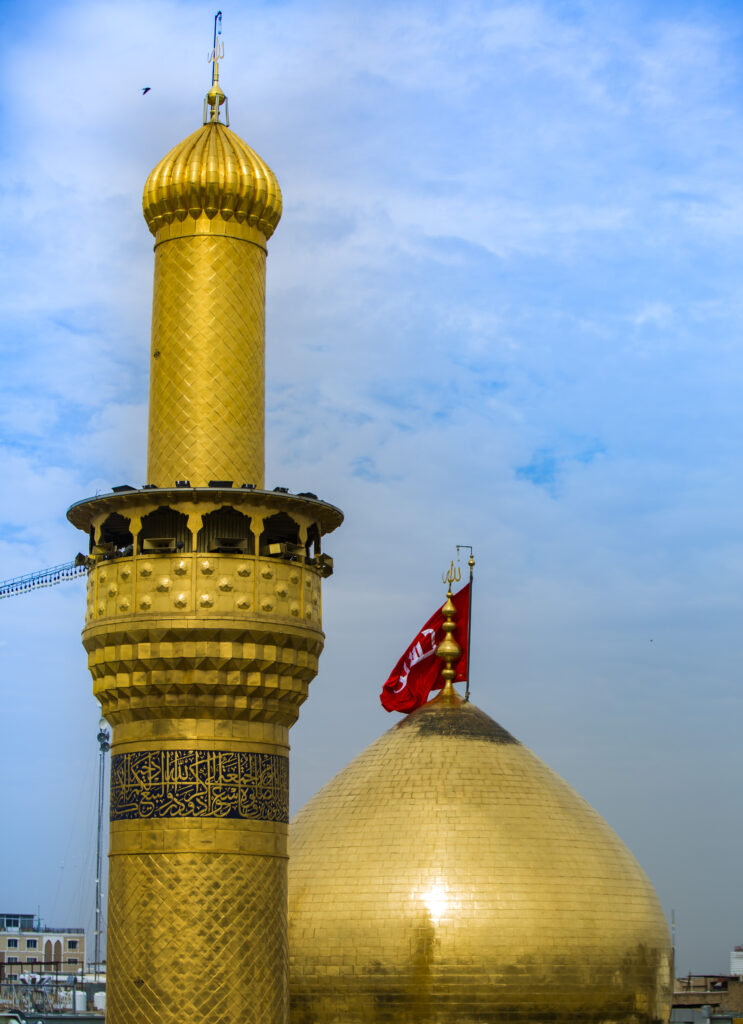Shrine of Imam Hussain
The Shrine of Imam Hussain (AS), located in Karbala, Iraq, is the resting place of Imam Hussain Ibn Ali, the grandson of the Prophet Muhammad (SAWS), through his daughter Fatima Al-Zahra and son-in-law Imam Ali ibn Abi Talib. Imam Hussain is the 3rd Shi’ite Imam.
Imam Hussain was the third Shia Imam and the son of Imam Ali, the fourth Sunni caliph, and first Shia Imam. In 680 CE, Imam Hussain and his followers were traveling to Kufa, a city in modern-day Iraq, to lead a rebellion against Yazid ibn Muawiya, a corrupt ruler who claimed to be the leader of the Muslim world. However, Yazid’s forces intercepted Imam Hussain and his followers in the desert outside of Karbala. Imam Hussain and his family and companions were denied access to food and water for several days. What followed was a brutal battle in which Imam Hussain and his small band of followers were vastly outnumbered and outmatched. Despite this, they refused to surrender and fought bravely until they were all killed. After the battle of Karbala, Imam Hussain’s body was beheaded and left on the battlefield for three days before being buried by his surviving family members and followers.
Over time, a small shrine was built around the grave of Imam Hussain, which gradually grew thanks to the devotion of his followers and later Imams. Today the story of Karbala has become a symbol of resistance against tyranny not only for Shias but humanity as a whole.
Timeline
- 680 CE: The martyrdom of Imam Hussain, many of his family members, ad companions, takes place at Karbala. After several days the body of Imam Hussain is buried by his surviving family members.
- 684 CE: The first small shrine is built around the grave of Imam Hussain.
- 684-749 CE: The Umayyad caliphate continues oppressing the descendants of Imam Ali and Hussain, especially their surviving family members.
- 850 CE: The shrine is renovated and expanded by the Abbasid caliph al-Mutawakkil.
- 1226 CE: The shrine is renovated and expanded by the Ayyubid Sultan al-Malik al-Kamil.
- 1622 CE: The Safavid Shah Abbas I of Persia commissions a major renovation of the shrine, which includes the construction of the current golden dome. This standardized many features of Shi’ite shrine construction.
- 1801 CE: The Wahhabi forces from Saudi Arabia attack Karbala and partially destroy the shrine.
- 1847 CE: The Ottoman governor of Iraq, Midhat Pasha, orders the restoration of the shrine.
- 1914 CE: The Ottoman government constructs a new entrance to the shrine.
- 1950 CE: The Iraqi government constructs a new courtyard and entrance to the shrine.
- 1977 CE: The Iraqi government constructs a new mosque next to the shrine.
- 2003 CE: The U.S. invasion of Iraq and the overthrow of Saddam Hussein leads to renewed access to the shrine for Shia Muslims.
- 2014 CE: The Islamic State of Iraq and Syria (ISIS) attacks and damages the shrine, but it is quickly repaired and restored.
- Present CE: The shrine continues to receive millions of pilgrims from around the Shi’ite world every year.
